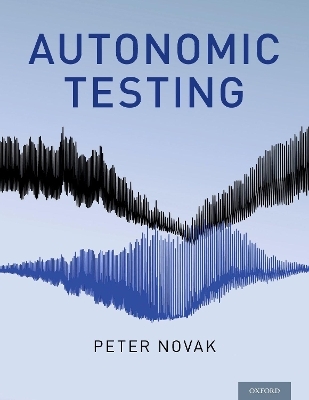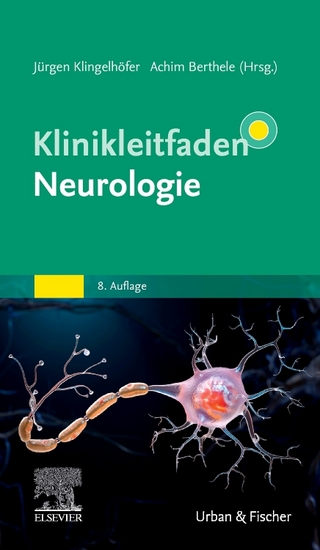
Autonomic Testing
Oxford University Press Inc (Verlag)
978-0-19-088922-7 (ISBN)
Autonomic Testing is the optimal guide for autonomic fellows, residents in neurology, general medicine and other specialties or for everybody that is interested in performing and interpreting autonomic tests. The unique aspect of this book is the use of the skin biopsies for assessment of small autonomic and sensory fibers as a routine part of autonomic testing. Another important feature of this book is the use of continuous cerebral blood flow velocity and end tidal CO2 monitoring in addition to standard heart rate and blood pressure recordings during the testing.
Comprised of 100 unique case studies, each case solves a particular clinical question. The presented cases include neurally mediated syncope, psychogenic pseudosyncope, orthostatic intolerance syndromes, autonomic failure, variety of small fiber neuropathies (with and without autoimmunity), autonomic dysfunction in neurodegenerative and hypermobile disorders.
Peter Novak, MD, PhD is the Chief of the Division of Autonomic Neurology and Director of the Autonomic Laboratory at Brigham and Women's Hospital at Boston and Assistant Professor of Neurology at Harvard Medical School. He is a board-certified neurologist and a board-certified autonomic specialist. He is a member of American Academy of Neurology, American Autonomic Society and a member of Autonomic Board of United Council for Neurologic Subspecialties (UCNS). He graduated from medical school in Bratislava, Slovakia and completed his neurology residency at the Ohio State University. He also completed postdoctoral studies focusing on cardiovascular and autonomic research at Charles University (Prague), University of Montreal, McGill University (Montreal) and Mayo Clinic. He has special interests in orthostatic intolerance syndromes, small fiber and autonomic neuropathies, and multiple system atrophy. He has written over 70 papers and presented at numerous conferences.
Introduction
Chapter 1. Classification of Autonomic testing patterns
Chapter 2. Functional Anatomy of the Autonomic nervous system
Chapter 3. Laboratory Equipment
Chapter 4 Tests Description
Chapter 5. Artefacts
Cases
Chapter 6. Case 1. Normal Example
Syncope, Neurally Mediated
Chapter 7. Case 2 Syncope, Mixed
Chapter 8. Case 3 Syncope, without Hyperventilation
Chapter 9. Case 4 Syncope, Vasodepressor
Chapter 10. Case 5 Syncope, Vasodepressor with Cerebral Autoregulatory Failure
Chapter 11. Case 6 Syncope, Cardiovagal with Prolonged Asystole
Chapter 12. Case 7 Syncope, Double.
Chapter 13. Case 8 Syncope due to Autonomic Failure.
Postural Tachycardia Syndromes (POTS)
Chapter 14. Case 9 Postural Tachycardia Syndrome (POTS), Neuropathic Type
Chapter 15. Case 10 Postural tachycardia syndrome with Hyperventilation
Chapter 16. Case 11 Postural Tachycardia Syndrome with Positive Antibodies Against the P/Q-type of Calcium Channel
Chapter 17. Case 12 Postural Tachycardia Syndrome with Presyncope and Syncope
Chapter 18. Case 13 Postural Tachycardia Syndrome with Syncope
Chapter 19. Case 14 Postural Tachycardia Syndrome with Hypermobile Ehlers-Danlos Syndrome
Chapter 20. Case 15 Postural Tachycardia Syndrome with Hyperventilation and Presyncope
Chapter 21. Case 16 Autonomic Failure or Postural Tachycardia Syndrome ?
Chapter 22. Case 17 Paroxysmal Dizziness in Postural Tachycardia Syndrome
Chapter 23. Case 18 871 Postural Tachycardia Syndrome and Small Fiber Neuropathy in Polycystic Ovary Syndrome
Chapter 24. Case 19 Postural Tachycardia Syndrome Due to Nephroptosis
Chapter 25. Case 20 Postural Tachycardia Syndrome Versus Syncope with Loss of Vision
Orthostatic Cerebral Hypoperfusion Syndrome (OCHOS)
Chapter 26. Case 21 Orthostatic Cerebral Hypoperfusion Syndrome, Intermittent
Chapter 27. Case 22 Orthostatic Cerebral Hypoperfusion Syndrome in Anaphylaxis
Chapter 28. Case 23 Orthostatic Cerebral Hypoperfusion Syndrome, Severe
Chapter 29. Case 24 Orthostatic Cerebral Hypoperfusion Syndrome with Vision Loss
Inappropriate Sinus Tachycardia
Chapter 30 Case 25 Inappropriate Sinus Tachycardia
Chapter 31 Case 26 Inappropriate Sinus Tachycardia and Orthostatic Cerebral Hypoperfusion Syndrome
Chapter 32 Case 27 Inappropriate Sinus Tachycardia Versus Postural Tachycardia Syndrome ?
Chapter 33 Case 28 Postural Tachycardia Syndrome with Reverse Tilt Test
Hypocapnic Cerebral Hypoperfusion (HYCH)
Chapter 34 Case 29 Hypocapnic Cerebral Hypoperfusion
Chapter 35 Case 30 Hypocapnic Cerebral Hypoperfusion with Paced Breathing
Chapter 36 Case 31 Hypocapnic Cerebral Hypoperfusion with an Artifact
Chapter 37 Case 32 Small Fiber Neuropathy, Orthostatic Hypertension and Hypocapnic Cerebral Hypoperfusion
Chapter 38 Case 33 Hypocapnic Cerebral Hypoperfusion with Cholinergic Small Fiber Neuropathy
Chapter 39 Case 34 Hypocapnic Cerebral Hypoperfusion and Effect of End Tidal CO2
Chapter 40 Case 35 Initial Orthostatic Hypotension
Chapter 41 Case 36 Orthostatic Hypertension
Chapter 42 Case 37 Severe Dyspnea and Preload Failure
Chapter 43 Case 38 Dizziness and Elevated Cerebral Blood Flow Velocity
Neurodegenerative Disorders
Chapter 44 Case 39 Hypothermia in Frontotemporal Dementia
Chapter 45 Case 40 Parkinson's Disease with Compensated Orthostatic Hypotension
Chapter 46 Case 41 Atypical Parkinsonism
Chapter 47 Case 42 Multiple System Atrophy versus Parkinson's Disease ?
Chapter 48 Case 44 Multiple System Atrophy
Chapter 49 Case 43 Multiple System Atrophy and Vitamin B12 Deficiency
Chapter 50 Case 45 Multiple System Atrophy ?
Chapter 51 Case 46 Amyotrophic Lateral Sclerosis
Multiple Sclerosis
Chapter 52 Case 47 Moebious Syndrome
Chapter 53 Case 48 Dyspnea
Chapter 54 Case 49 Dizziness due to Multiple Sclerosis or Due to Dysautonomia?
Small Fiber Neuropathy
Chapter 55 Case 50 Small Fiber Neuropathy and Severe Autonomic Failure in Diabetes
Chapter 56 Case 51 Small Fiber Neuropathy and Transient Orthostatic Hypotension in Diabetes
Chapter 57 Case 52 Painful Small Fiber Neuropathy
Chapter 58 Case 53 Small Fiber Neuropathy with Striational Antibodies
Chapter 59 Case 54 Polyneuropathy Affecting Large and Small Fibers in Multiple Autoimmune Disorders
Chapter 60 Case 55 Small fiber neuropathy with Autonomic Failure
Chapter 61 Case 56 Autoimmune Small Fiber Neuropathy with Positive Ganglionic Acetylcholine Receptor Antibody
Chapter 62 Case 57 Small Fiber Neuropathy and Hypocapnic Cerebral Hypoperfusion with Elevated Antibodies to N-type Calcium Channel
Chapter 63 Case 58 Small Fiber Neuropathy with Positive Autoantibodies to N-type Calcium Channel
Chapter 64 Case 59 Small Fiber Neuropathy and Autonomic Failure with Elevated Voltage-gated Potassium Channel Antibodies
Chapter 65 Case 60 Small Fiber Neuropathy, Seronegative, Treated with Immune Globulins.
Chapter 66 Case 61 Small Fiber Neuropathy, Patchy, with Elevated Voltage-gated Potassium Channel Antibodies
Chapter 67 Case 62 Small Fiber Neuropathy with Symptomatic Improvement on Immune Globulins
Chapter 68 Case 63 Small Fiber Sensory Neuropathy with Elevated Ganglionic Acetylcholine Receptor Antibody Responding to Immunoglobulins
Chapter 69 Case 64 Ehlers-Danlos Syndrome and Small Fiber Neuropathy
Chapter 70 Case 65 Ehlers-Danlos Syndrome with Postural Tachycardia Syndrome, Presyncope and Anxiety
Chapter 71 Case 66 Hyperventilation Syndrome, Small Fiber Neuropathy and Postural Tachycardia Syndrome in Ehlers-Danlos Syndrome
Chapter 72 Case 67 Ehlers-Danlos Syndrome with Postural Tachycardia Syndrome and Psychogenic Pseudosyncope
Chapter 73 Case 68 Unknown Connective Tissue Disorder and Postural Tachycardia Syndrome
Chapter 74 Case 69 Small Fiber Neuropathy, Hypocapnic cerebral hypoperfusion and Generalized Hypermobility Spectrum Disorder
Chapter 75 Case 70 Small Fiber Neuropathy and Generalized Hypermobility Spectrum Disorder
Chapter 76 Case 71 Small Fiber Neuropathy, Postural Tachycardia and Mast Cell Activation Syndromes
Chapter 77 Case 72 Postural Tachycardia, Mast Cell Activation and Ehlers-Danlos Syndromes
Chapter 78 Case 73 Dysautonomia Due to Mast Cell Activation Syndrome or due to Psoriatic Arthritis ?
Chapter 79 Case 74 Small Fiber Neuropathy and Lyme Disease
Chapter 80 Case 75 Small Fiber Neuropathy, Cerebral Autoregulatory Failure and Posttreatment Lyme Disease syndrome
Chapter 81 Case 76 Small Fiber Neuropathy, Hypocapnic Cerebral Hypoperfusion and Posttreatment Lyme Disease Syndrome
Chapter 82 Case 77 Painful Small Fiber Neuropathy in Posttreatment Lyme disease Syndrome.
Chapter 83 Case 78 355 Wilson disease
Chapter 84 Case 79 Small Fiber Neuropathy and Abnormal Cerebral Blood Flow.
Chapter 85 Case 80 Vitamin B12 Deficiency
Chapter 86 Case 81 Hypovolemia in Valsalva Maneuver
Chapter 87 Case 82 Postural Tachycardia Syndrome and Hypovolemia
Paroxysmal Abnormalities
Chapter 88 Case 83 Small Fiber Neuropathy and Preload Failure
Chapter 89 Case 84 Intermittent Confusion
Chapter 90 Case 85 Rhythmic Dizziness
Chapter 91 Case 86 Paroxysmal Dysautonomia
Chapter 92 Case 87 Intermittent Supine Hypotension
Chapter 93 Case 88 Intermittent Vision Loss in Cervical Spine Injury
Chapter 94 Case 89 Periodic Apnea
Chapter 95 Case 90 Repetitive Dizziness
Chapter 96 Case 91 Primary Cerebral Autoregulatory Failure
Psychogenic Disorders
Chapter 97 Case 92 Anxiety
Chapter 98 Case 93 Anxiety Mimicking Postural Tachycardia Syndrome
Chapter 99 Case 94 Anxiety and Postural Tachycardia Syndrome
Chapter 100 Case 95 Fluctuating Psychogenic Dizziness
Chapter 101 Case 96 Functional Neurologic Disorder and Postural Tachycardia Syndrome
Chapter 102 Case 97 Unusual Postural Spells
Chapter 103 Case 98 Repetitive Psychogenic Pseudosyncope
Chapter 104 Case 99 Mixed Tilt Patterns in Rheumatoid Arthritis
Chapter 105 Case 100 Dizziness in Concussion
Index
| Erscheinungsdatum | 21.03.2019 |
|---|---|
| Verlagsort | New York |
| Sprache | englisch |
| Maße | 277 x 213 mm |
| Gewicht | 1361 g |
| Themenwelt | Medizin / Pharmazie ► Medizinische Fachgebiete ► Neurologie |
| ISBN-10 | 0-19-088922-5 / 0190889225 |
| ISBN-13 | 978-0-19-088922-7 / 9780190889227 |
| Zustand | Neuware |
| Haben Sie eine Frage zum Produkt? |
aus dem Bereich


